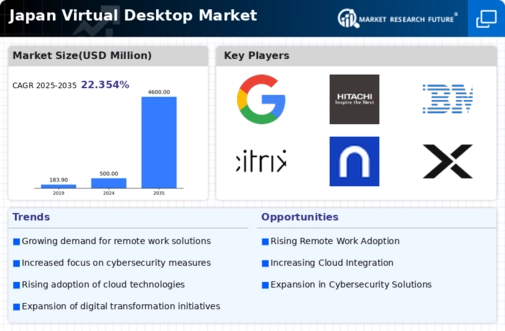The Japan Virtual Desktop Market is evolving with notable shifts caused by the growing demand for remote working options and new security protocols. Many firms are investing in virtual desktop infrastructures as the Japanese workforce is now accustomed to flexible working schedules. Under the "Society 5.0" initiative, the government is promoting digital transformation in various industries and emphasizing the need for sophisticated IT infrastructure that supports remote work. In addition, other businesses have come to realize the ease of managing IT systems and cost savings that come with virtual desktops.
This change leads to better spending and lowers hardware spending since most tasks can be executed on centralized servers. Virtual desktops offer greater protection and control of sensitive information which is critical in a data heavy environment like Japan. This makes computer security one of the most important issues. There is more flexibility in exploring the application of AI and machine learning technologies to virtual desktop systems. As most companies are looking for ways to increase productivity, these technologies can improve performance, streamline administrative processes, and enhance user navigation.
There are also opportunities for advancement in the education and health care fields, where safe and customizable access to applications and information is necessary. Of late, the increased availability of collaborative tools in virtual desktop environments has become widespread, facilitating communication among remote teams. Businesses are also spending money on user training to take full advantage of the benefits offered by virtual desktops, resulting in increased productivity and user satisfaction. In summary, the Japan Virtual Desktop Market is responding to the shifts regarding work by incorporating advancement, security, and efficiency into its strategies for growth.
Japan Virtual Desktop Market Drivers
Increasing Demand for Remote Workforce Solutions
As businesses continue to adapt to remote and hybrid working environments, the demand for powerful and secure virtual desktop solutions is expected to rise, thereby expanding the Japan Virtual Desktop Market.
Focus on Cybersecurity and Data Protection
With increasing cyber threats, Japanese organizations are prioritizing cybersecurity and data protection, especially in the context of remote work. A report from the National Center of Incident Readiness and Strategy for Cybersecurity indicated that cybercrime incidents in Japan surged by over 50% in 2020 compared to the previous year. As a result, companies are looking toward Virtual Desktop solutions that offer integrated security features to safeguard sensitive information.
Leading enterprises in the Japan Virtual Desktop Market Industry, such as Hitachi and SoftBank, are investing heavily in cybersecurity capabilities within their virtual desktop offerings, making this a strong driver for market growth.
Growing Adoption of Cloud Computing Technologies
As cloud computing becomes integral to corporate strategies, the demand for virtual desktop solutions is expected to follow suit.





















Leave a Comment